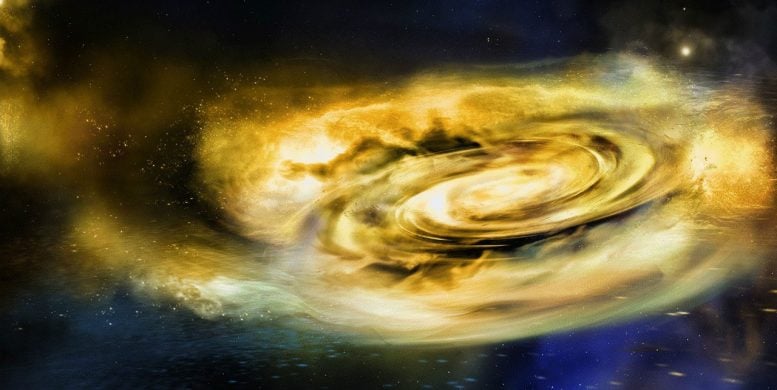
Illustration of strong winds disrupting the outer disc of material surrounding a stellar-mass black hole (Image: NASA/Swift/A. Simonnet, Sonoma State University)
New research shows the first evidence of strong winds around black holes throughout bright outburst events when a black hole rapidly consumes mass.
The study, published in Nature, sheds new light on how mass transfers to black holes and how black holes can affect the environment around them. The research was conducted by an international team of researchers, led by scientists in the University of Alberta’s Department of Physics.
Using data from three international space agencies spanning 20 years, the scientists used new statistical techniques to study outbursts from stellar-mass black hole X-ray binary systems. Their results show evidence of consistent and strong winds surrounding black holes throughout outbursts. Until now, strong winds had only been seen in limited parts of these events.
“Winds must blow away a large fraction of the matter a black hole could eat,” described Bailey Tetarenko, Ph.D. student and lead author on the study. “In one of our models, the winds removed 80 percent of the black hole’s potential meal.”
Depending on their size, stellar-mass black holes have the capacity to consume everything within a 3 to 150-kilometer (2 to 93-mile) radius. “Not even light can escape from this close to a black hole,” explained Gregory Sivakoff, associate professor of physics and co-author. Other, much larger black holes, called supermassive black holes, appear to have affected the formation of entire galaxies. “But even supermassive black holes are smaller than our solar system. While they are small, black holes can have surprisingly large effects,” explained Sivakoff.
So, what exactly causes these winds in space? For now, it remains a mystery. “We think magnetic fields play a key role. But we’ll need to do a great deal of future investigation to understand these winds,” explained Craig Heinke, associate professor of physics and co-author.
Reference: “Strong disk winds traced throughout outbursts in black-hole X-ray binaries” by B. E. Tetarenko, J.-P. Lasota, C. O. Heinke, G. Dubus and G. R. Sivakoff, 22 January 2018, Nature.
DOI: 10.1038/nature25159









Be the first to comment on "New Research Sheds Light on How Mass Transfers to Black Holes"